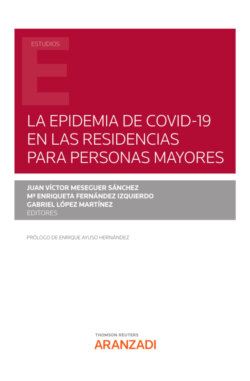Читать книгу La epidemia de COVID-19 en las residencias para personas mayores - M. Enriqueta Fernández Izquierdo - Страница 23
На сайте Литреса книга снята с продажи.
VII. Referencias bibliográficas 1. Referencias científicas
ОглавлениеBarrick, M. R., y Mount, M. K. (1991). The big five personality dimensions and job performance: A meta-analysis. Personnel Psychology, 44, 1–26. DOI: 10.1111/j.1744-6570.1991.tb00688.x.
Berry, C. M., Ones, D. S., y Sackett, P. R. (2007). Interpersonal deviance, organizational deviance, and their common correlates: A review and metaanalysis. Journal of Applied Psychology, 92, 410–424. DOI:10.1037/0021– 9010.92.2.410.
Chiaburu, D., Oh, I-S, Berry, C., y Li, N. y Gardner, R. (2011). The Five-Factor Model of Personality Traits and Organizational Citizenship Behaviors: A Meta-Analysis. The Journal of Applied Psychology, 96, 1140-66. DOI: 10.1037/a0024004.
Chorgwicka, B. (2010). Las facetas de los Big Five y la predicción del desempeño. (Tesis Doctoral no publicada). Facultad de Psicología, Universidad de Santiago de Compostela.
De Raad, B. (2000). The Big Five Personality Factors. The Psycholexical Approach to Personality. OH: Hogrefe & Huber.
Hernández-Flores, J.R. (2012). Efectos que un ambiente de trabajo basado en facetas de la responsabilidad produce sobre la mejora continua: el orden y el cumplimiento de estándares. (Tesis Doctoral no publicada). Universidad de Navarra. https://dadun.unav.edu/bitstream/10171/28183/1/TESIS%20FINAL%20v9.2.pdf.
Hogan, R. T. (1991). Personality and personality measurement. En M. D. Dunnette y L. M. Hough (Eds.), Handbook of Industrial and Organizational Psychology (2.ª ed., pp. 873–919). Palo Alto, CA: Consulting Psychologists Press.
Jackson, D. N., Paunonen, S. V., Fraboni, M., y Goffin, R. D. (1996). A five-factor versus six-factor model of personality structure. Personality and Individual Differences, 20, 33-45.
Jensen-Campbell, L., Knack, J., Waldrip, A., y Campbell, S. (2007). Do big five personality traits associated with self-control influence the regulation of anger and aggression? Journal of Research in Personality, 41, 403– 424. DOI: 10.1016/j.jrp.2006.05.001.
Judge, T. A., Rodell, J. B., Klinger, R. L., & Simon, L. S. (2013). Hierarchical representations of the Five Factor Model of Personality in predicting job performance: Intergrating three organizing frameworks with two theoretical perspectives. Journal of Applied Psychology, 98, 875–925. DOI:10.1037/a0033901.
Kluemper, D., Mclarty, B., y Bing, M. (2014). Acquaintance Ratings of the Big Five Personality Traits: Incremental Validity Beyond and Interactive Effects With Self-Reports in the Prediction of Workplace Deviance. The Journal of Applied Psychology. 100. DOI: 10.1037/a0037810.
Li, N., Barrick, M. R., Zimmerman, R. D., y Chiaburu, D. S. (2014). Retaining the productive employee: The role of personality. The Academy of Management Annals, 8, 347–395. DOI:10.1080/19416520.2014.890368.
McCrae, R. R., y Costa, P.T., Jr. (1987). Validation of the five-factor model of personality across instruments and observers. Journal of Personality and Social Psychology, 52, 81–90. DOI: 10.1037/0022-3514.52.1.81.
McCrae, R.R., Costa, P.T., Jr. (1997). Personality trait structure as a human universal. American Psychologist, 52, 509 –516. DOI: 10.1037/ 0003-066X.52.5.509.
McCrae, R.R., y John, O.P. (1992). An introduction to the Five Factor Model and his applications. Journal of Personality, 60 (2), 162-215.
McCrae, R. R. Martin, T. A., y Costa, P.T., Jr. (2015). Age trends and age norms for the NEO personality inventory– 3 in adolescents and adults. Assessment, 12(4), 363-373. DOI: 10.1177/1073191105279724.
McCrae, R. R., Terracciano, A., y 78 Miembros del Personality Profiles of Cultures Project. (2005). Universal features of personality traits from the observer’s perspective: Data from 50 cultures. Journal of Personality and Social Psychology, 88, 547–561. DOI: 10.1037/0022-3514.88.3.547.
Oh, I., Wang, G., y Mount, M. K. (2011). Validity of observer rating of the Five-Factor model of personality traits: A meta-analysis. Journal of Applied Psychology, 96, 762–773. DOI: 10.1037/a0021832.
Robins, R. W., Caspi, A., y Moffitt, T. E. (2000). Two personalities, one relationship: Both partners’ personality traits shape the quality of their relationship. Journal of Personality and Social Psychology, 79, 251–259. DOI: 10.1037/0022-3514.79.2.251.
Rotundo, M., y Sackett, P. R. (2002). The relative importance of task, citizenship, and counterproductive performance to global ratings of job performance: A policy-capturing approach. Journal of Applied Psychology, 87, 66 –80. DOI:10.1037/0021-9010.87.1.66.
Sung, S-Y., Choi, J., y Kim-Jo, T. (2014). Personality Dissimilarity and Work-Related Outcomes: Asymmetric Effects and Moderating Role of Group Tenure. Group Dynamics: Theory, Research, and Practice, 18(1). DOI: 10.1037/a0034411.
Welbourne, J., Miranda, G., y Gangadharan, A. (2020). Effects of employee personality on the relationships between experienced incivility, emotional exhaustion, and perpetrated incivility. International Journal of Stress Management, 27 (4), 335-345. DOI: 10.1037/str0000160.
Wilson, C. y Nagy, Mark. (2017). The Effects of Personality on Workplace Bullying. The Psychologist-Manager Journal. 20 (3), 123–147. DOI: 10.1037/mgr0000054.
